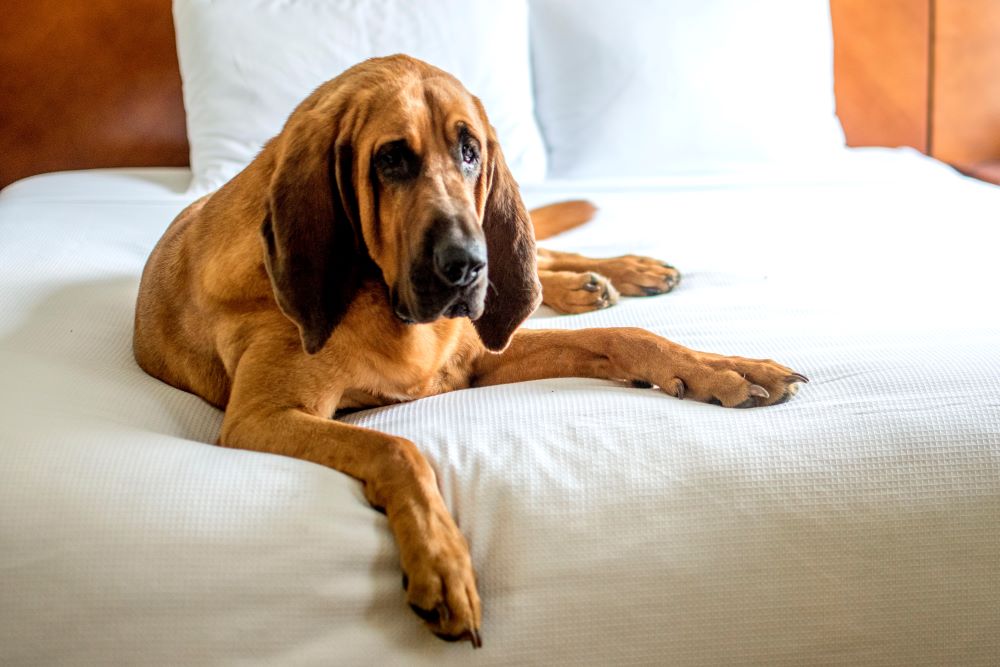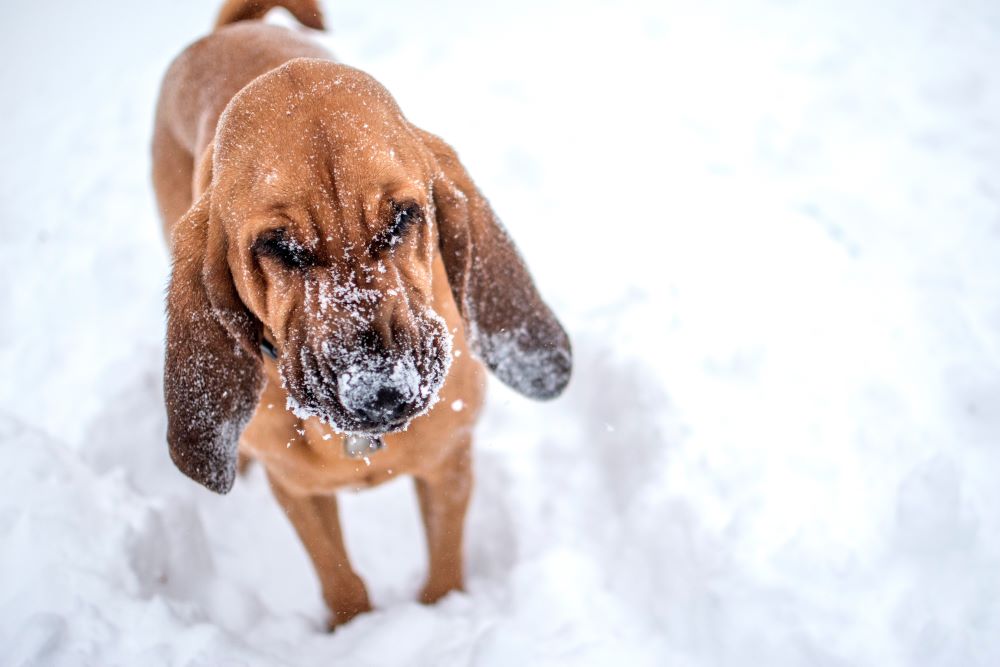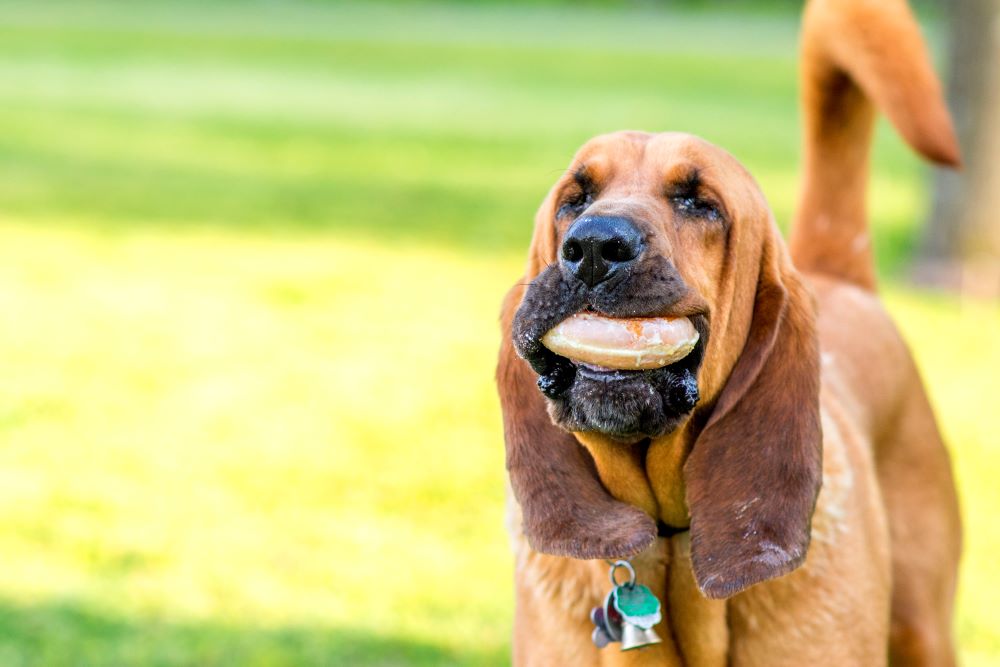Get Pet Insurance for your Cat & Dog

Zero
Documentation
Quick
Claim Process
Affordable
Premium
Terms and conditions apply*
- {{species}}
- {{indoorOutdoor}}
- {{suminsured}}
Bloodhound Dog Breed Characteristics & Information

The Bloodhound dog, with its distinctive droopy ears, deep-set eyes and incredibly powerful nose, is a breed that has captured the hearts of dog lovers worldwide. These remarkable canines have a unique set of characteristics and needs that set them apart from other breeds.
In this article, we will delve into the unique qualities of Bloodhound dogs, their characteristics, care requirements, training methods and common health issues.
What Defines Bloodhound Dogs?
Bloodhounds are not rare but are distinctive for their exceptional sense of smell, considered one of the keenest among dogs. As per The Kennel Club 2021, only 19 new bloodhounds were registered in the world.
They're renowned for their tracking abilities, often employed in police work for search-rescue purposes. They are very intelligent and make affectionate pets, but their size and energy demand dedicated care and space.
What are the Characteristics of Bloodhound Dogs?

It's important to look into the various characteristics of Bloodhounds in order to understand and admire them more.
- Lifespan: The average lifespan of a Bloodhound is around 7 to 12 years. Proper care and a healthy lifestyle can contribute to a longer life for your furry friend.
- Height: Bloodhounds are large dogs, with males typically standing around 25 to 27 inches at the shoulder and females slightly shorter at 23 to 25 inches.
- Colour: Bloodhounds come in a variety of colours, including black and tan, liver and tan, and red. They often have a black saddle marking on their back.
- Weight: Adult Bloodhound dogs generally weigh between 41 to 50 kgs for males and 36 to 45 kgs for females.
- Behaviour and Personality: They are sociable, good with children and other pets, and mild-mannered. While being friendly, they can be stubborn sometimes.
- Living Conditions: The bloodhounds require a lot of room. They require a house with a large, fenced-in yard; they are not suitable for living in apartments.
- Powerful Nose: Their olfactory receptors are highly developed, and they can detect scents over great distances due to this, they are used in search-rescue operations.
- Coat: Bloodhounds have a short, dense coat that is easy to care for. Their coat is weather-resistant, making them suitable for various climates.
- Breed Group: Bloodhounds belong to the Hound group, which is further divided into the Scent Hound subgroup. This emphasises their scent-tracking abilities.
- Temperament: Bloodhounds are gentle and affectionate by nature. They are known for their loyalty and devotion to their human pack, often forming strong bonds
How to Train Bloodhound Dogs?

Bloodhound dogs are independent, stubborn, affectionate and dedicated. Bloodhound training requires skills, consistency, and patience. The following tips can help you train a Bloodhound:
- Use Clicker Training: Using a clicker can be an effective way to reinforce positive behaviours. Bloodhounds can be stubborn, so it's essential to correct undesirable behaviours immediately. Click and praise when your dog obeys commands.
- Simple Commands: Start with basic commands like sit, stay, and come. Consistency and positive reinforcement are key. Reward your Bloodhound with treats, praise, and affection when they respond correctly.
- Scent Training: Given their extraordinary scenting abilities, consider engaging in scent work or tracking exercises with your Bloodhound dog. This is a fun and mentally stimulating activity that aligns with their natural instincts.
- Socialisation: To guarantee that your Bloodhound is well-mannered and friendly towards people and other animals, early socialisation is essential. From an early age, expose puppies to a variety of settings, people, and circumstances.
- Leash Walk: Bloodhounds are strong and may pull on the leash. Invest in a sturdy leash and harness, and teach them to walk on a leash without pulling, ensuring enjoyable walks for both the dog and the owner.
- Vocal Training: They are known for excessive barking when they are on a scent trail. Teach the 'quiet' command and reward your Bloodhound when they stop barking. Identifying the triggers for barking can help in addressing the root cause.
What are the Health Problems with Bloodhound Dogs?
Though they tend to be healthy dogs overall, bloodhounds might have some health problems like any other breed. Seven common health problems to be aware of include:
- Hip Dysplasia: This is a common issue in breeds like Bloodhound dogs. It involves the malformation of the hip joint, leading to discomfort and decreased mobility.
- Ear Infections: Bloodhounds' long ears make them susceptible to ear infections. Regular cleaning and inspection are crucial to prevent this common issue.
- Cherry Eye: Cherry eye is a condition where the gland in the third eyelid becomes inflamed and visible. Surgery may be necessary to correct this condition.
- Calluses: Due to their heavy bodies, Bloodhounds can develop calluses on their elbows from lying on hard surfaces. Provide soft bedding and padding to prevent this.
- Stomach Cramps: Bloodhound dogs are prone to gastric torsion. Feed smaller, more frequent meals and avoid strenuous exercise after eating to reduce the risk.
- Canine Degenerative Myelopathy: A neurological disorder in Bloodhounds that results in weakness and impaired nerve function in the back legs.
- Hypothyroidism: A condition in Bloodhounds occurs when the thyroid hormone produced by the body is not produced enough, causing dry skin and a dry coat.
How to Take Care of Bloodhound Dogs?
For this high-maintenance Bloodhound dog's health and well-being, proper care is necessary. The primary aspects of providing care for these pets are as follows:
- Diet and Nutrition: A Bloodhound's diet should include meat, bone, lamb, duck, eggs, turkey, offal, and a limited quantity of plant-based foods. These foods all contribute essential vitamins and minerals to mealtimes.
- Feeding: The amount of food your dog needs depends on their age. Generally, they should eat 4 to 8 cups of good dog food split into two meals each day. Some Bloodhound owners give smaller, more frequent meals to avoid Bloat.
- Grooming: Bloodhounds have a short coat that requires minimal grooming. Weekly brushing can help remove loose hair and maintain their skin's health. With that, wipe their wrinkles daily with a damp washcloth.
- Exercise: Bloodhounds are very active and crave lots of exercise. Taking them for daily walks and playtime. Be cautious not to over-exercise in hot weather, as their loose skin can make them prone to overheating.
- Ear Care: Bloodhound dogs' long ears can be a source of concern. Their ears should be checked regularly for any signs of infection, and they should be cleaned and dried carefully. Be gentle to avoid injuring the delicate ear canal.
- Slobber Care: Bloodhounds are known for their excessive drooling, especially after eating or drinking. Keep a towel handy to wipe their drool and prevent it from causing skin irritation or staining your furniture.
Bloodhound dogs are not only extraordinary in their abilities and distinctive appearance but also possess a rich history that dates back centuries.
Beyond their droopy eyes and slobbery charm lies a breed that has played vital roles in law enforcement and search-and-rescue missions.
Providing the proper care and training will ensure their well-being and create a lasting bond that celebrates the distinctive and captivating spirit of the Bloodhound.












